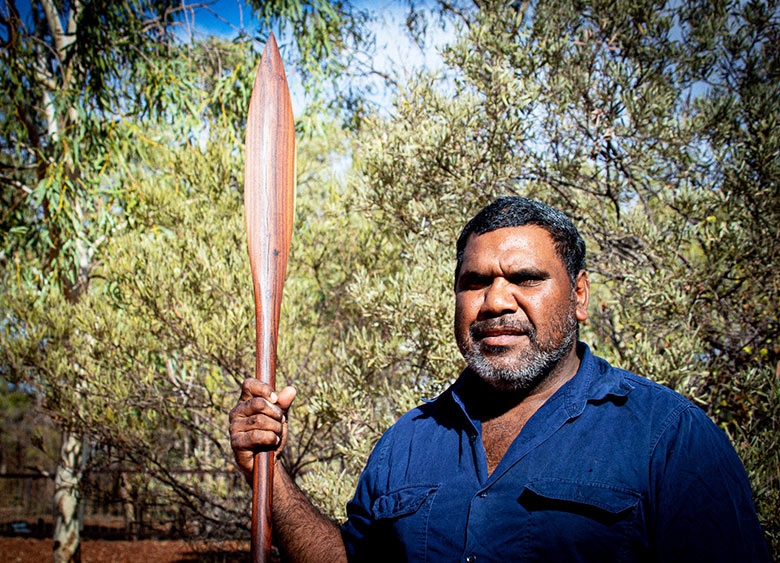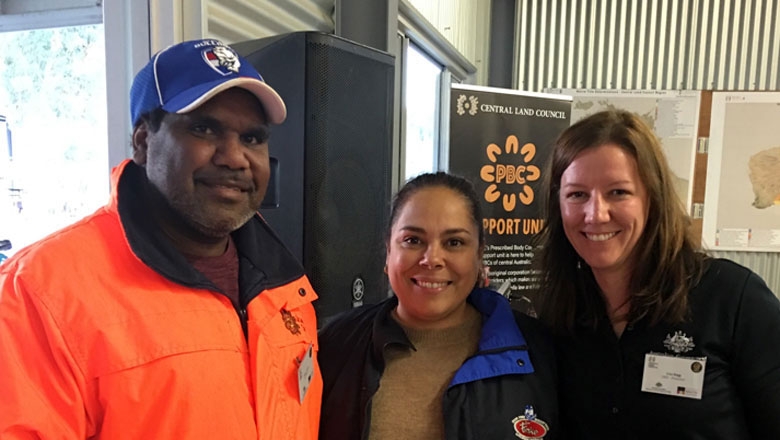Incorporating Aboriginal law
How can a corporation’s registered rule book best reflect Aboriginal cultural structures? Patta Aboriginal Corporation RNTBC is looking for answers, and has some ideas.
Tennant Creek, Northern Territory: Patta Warumungu people were the first Aboriginal group in Australia to negotiate a consent determination within a township. In that sense, Patta Aboriginal Corporation RNTBC has always been at the intense edge of the interaction between western law and Aboriginal law. Then and now, Aboriginal governance structures have been at the centre of all decision-making processes. The corporation is working on reinforcing these processes by having them reflected in their rule book.

Jimmy Frank
Jimmy Frank is one of ten directors of this innovative and determined RNTBC. He spoke at the PBC forum in Ross River in June 2019 about the Patta Warumungu people’s journey and the challenges they faced:
- to have their native title rights recognised
- having to adopt whitefella law to use the corporation to manage those rights and interests
- when the negotiation committee held discussions with the NT government and traditional owners, the Patta Warumungu peoples, which resulted in the National Native Title Tribunal mediating between the parties
- the struggles for the corporation over the next eight years that were influenced by the passing of key family members, and external forces like the Northern Territory Emergency Response (the NT Intervention).
As a way to move forward this RNTBC requested external support to:
- build a common knowledge base among native title holders
- reaffirm the cultural knowledge structures
- steer through whitefella law.

Jimmy Frank, Dayna Lister and Lisa Hugg at the PBC forum in Ross River, June 2019
Jimmy Frank tells the story of the corporation’s journey.
In 2001 a negotiating committee of senior Patta Warumungu Elders including younger Patta Warumungu members was set up to negotiate our native title claim. The key negotiating was done by Elders and other people, with the younger ones involved to keep track of talks and share information with family members.
Some very complex issues were talked about. It was important that everyone was kept informed and went to meetings. The elders took this chance to talk with the younger generations, teach them about important places and talk about how past generations used the land.
As part of the negotiations, the elders decided to give up native title rights to areas within the township to enable the town to grow, and to extend the land for the cemetery and the landfill and waste management facility.
In 2007 native title was determined over the township of Tennant Creek and Patta Aboriginal Corporation was nominated as the RNTBC. The directors were representatives from different family groups, reflecting the cultural structures of the Patta Warumungu people. The corporation started off really strong.
Sadly, in the years that followed we lost a lot of our cultural leaders. When key elders passed away, a lot of cultural knowledge in family groups was lost. We were also forced to live and work with the ’Intervention’. Directors started to lose interest; but the work kept coming in. The board met regularly, but often lacked the quorum it needed to make decisions. Significant social change was under way as a result of the intervention, and people became disengaged from collective and community ownership of decision-making. At every AGM, the same directors were re-elected even though they remained disengaged from corporation processes. It was frustrating, and hard to resolve some of the corporation’s issues.
The Patta Warumungu people were in conflict and divided so the directors asked the Central Land Council (CLC) to help. With funding from the Department of the Prime Minister and Cabinet, the CLC engaged two consultants (male and female) who had previously worked with the Patta Warumungu families.
The consultants researched historical and contemporary documents, including land claim materials, and they talked with everyone. Then they got all the families together for a large meeting to work through connection to country and decision-making roles about country. After consulting native title holders, the consultants drafted several charts outlining agreed processes for making native title decisions, identifying the dreaming and skin groups, and who needs to be consulted about what.
The significant social change impacted our younger generation by causing them to lose lose respect for our cultural protocols. The charts helped put families together; they show where everyone fits. And they help to identify who are the decision-makers and who are the helpers.
Our path is becoming clear.
We are teaching our families about their connection to each other and to Country, the right way. We are getting the younger generation interested in Country and in learning about Country—and our elders are teaching about Country. We are getting families involved in site clearances and doing country visits.
We are also making space to teach and learn through our museum, Nyinkka Nyunyu, and Kunjarra, an important site that is now ours forever.
Having a strong PBC is about having strong culture. Finding a way to include more of our cultural structures in our rule books will help us run our PBCs. Directors are strong in their view that:
- Patta’s current rule book is structured towards mainstream governance processes.
- Patta’s current rule book is structured to be managed by bureaucrats who have little understanding of operating within two worlds.
- They need to ensure that there is balance in Patta’s decision-making rules, as they need to be mindful of Aboriginal decision-making and other Patta Warumungu native title holders.
We commend Patta for staying true to its cultural purpose throughout the native title journey, and look forward to seeing traditional culture and Aboriginal decision-making reflected in its rule book.